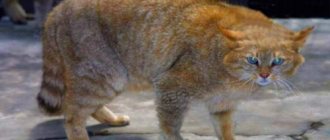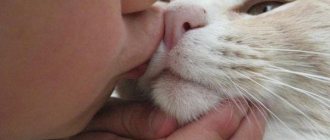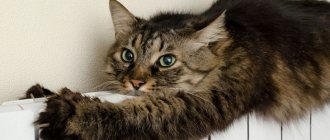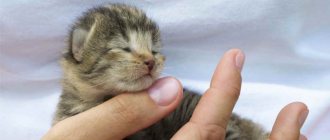The sudden appearance of tremors in a pet’s body is a cause for concern for the owner.
The cause of trembling is the involuntary contraction of one or several groups of muscle fibers.
Both physiological and pathological factors can provoke tremors in the body. Only a veterinarian can help determine the exact cause.
When cats can shake
Cats can tremble not only in their sleep, but also while awake. The main problem for the owner is determining the cause of the trembling and whether any disease is present.
If this phenomenon occurs quite often, it is necessary to determine the room temperature. If the room temperature is not comfortable for the pet, measures should be taken to provide warmth to the pet. The measure consists of raising the room temperature or providing the animal with warm bedding and eliminating drafts.
It is necessary to provide cats with warm bedding.
Sign that the cat is freezing
A sign that your pet is freezing can be the “curl” position adopted during sleep and a deeply hidden nose.
The cat hides its nose if it is cold.
Light twitching
According to available data and statistics, most cats regularly experience small twitches while sleeping. Some experts believe they may be similar to what people experience during REM eye movement sleep. During rapid eye movement, people dream and experience a deep sense of pleasure in sleep. Those little twitches your kitten or cat makes could be simple movements they make while chasing a mouse or playing with other cats in their dreams.
Sleep epilepsy or sleep disorder
How to distinguish between nocturnal seizures, are seizures a manifestation of epilepsy during sleep or is it a sleep disorder?
Differential diagnosis of paroxysmal events during sleep
To clarify the nature of nocturnal attacks, an objective research method is video EEG polysomnography. An option for diagnosing epilepsy in sleep is video EEG monitoring; studies are more informative after sleep deprivation.
If during a paroxysm epiactivity is simultaneously recorded on the EEG of sleep, then these paroxysms are of epileptic origin, that is, they are epileptic seizures in sleep.
Night attacks can be short and not accompanied by epileptiform EEG discharges; then these disorders of non-epileptic origin are more often classified as parasomnias.
Sleep disorders are often associated with certain stages of sleep and have a characteristic clinical picture.
At an appointment with an epileptologist, there are also options when the patient has nocturnal seizures and epilepsy, but this is not epilepsy.
Let us give a clinical example of seizures during sleep, accompanied by epileptiform activity on the EEG, but not related to epilepsy.
A 3-year-old boy came to see him with nocturnal paroxysms in the form of sleepwalking and sleep-talking. According to my mother: “2 hours after falling asleep, he gets out of bed, says, and walks around the apartment. It's like he's looking for something. More often than not, something is unclear. Some of the words can be understood; they are associated with sleep, with the events of the day. Sometimes the son laughs, cries, moans, is afraid, and is in a hurry. The eyes are open, but the gaze is unconscious or “wild”. After about 10 minutes I manage to calm him down and put him to bed. He falls asleep calmly. After treatment with sedatives, there was a break in his sleepwalking for 4 months, and then gradually became more frequent up to 2-4 times a month.” On the EEG, the patient has epiactivity of the type of benign epileptiform discharges of childhood in a small amount in the background and during sleep. When conducting an EEG with sleep deprivation: during sleep recording, neurophysiologists described a paroxysm (sat down on the bed, did not react, said a few words), but at this moment no epiactivity was noted in the EEG. A diagnosis was made: Parasomnias (sleeping, sleeping). Concomitant diagnosis: Benign epileptiform disorders of childhood. There are currently no data for active epilepsy. Antiepileptic drugs were never prescribed to this patient. Emphasis was placed on the need to maintain a rational daily routine. In therapy, he received sedatives or nootropics in age-related doses in the form of monotherapy (pantothenic acid, adaptol, atarax, phenibut, decoction of sedative herbs, novopassit) in courses of 1-2 months, 1-3 courses per year. The response to such therapy is always good: the parasomnias described above completely stopped for 4-8 months or decreased significantly; could be of an erased nature (sits on the bed in a dream, sits for 3-5 seconds, lies down and sleeps further; no more than 1-2 times a month). The child has been observed by an epileptologist for several years. Over time, complaints about sleep disturbances gradually become less and less. According to the EEG, epiactivity of the DERD type persists: in different recordings it may be in a small index or absent.
A kitten's active sleep is not a reason to worry
Most of the speculation surrounding the concern comes from kitten owners. We dare to assure you that if your cat twitches in his sleep, but he is not yet 12-15 months old, this is normal . Don't worry if the kitten sleeps in an unnatural position or if its eyes are slightly open. The first is explained by the fact that kittens are not so demanding of comfort, the second is due to the presence of a third eyelid, a transparent film that protects the eye during sleep, even if it is open.
The kitten may twitch violently, roll over, and even meow after stress or active play. If the baby is sleeping and you notice that his paws are twitching, it means that the four-legged animal is walking or running in its sleep. Until 1.5–2 years of age, activity in the REM phase is absolutely normal and is explained by an incompletely formed nervous system.
Motor activity during sleep of an adult cat
It is normal for a cat to twitch slightly during sleep once it has passed adolescence. Adaptation of an animal in the outside world and among “its own kind”, strengthening its nervous system, completing the construction of “owner-pet” relationships contributes to its psychological stability. The cat does not experience significant stress and therefore sleeps more peacefully.
In an adult, REM sleep is accompanied by:
- infrequent and not pronounced movements of the paws;
- twitching of the lip, mustache, ears;
- motor activity of the tail;
- rare screams, meows, growls.
If a cat older than two years old experiences emotions characteristic of a kitten in a dream, it is highly likely that it may be diagnosed with behavioral changes - increased nervousness, aggressiveness. It is difficult for such animals to adapt close to humans, and sometimes living together becomes impossible.
Sleep Features
- Experts constantly study the behavior of furry animals, so they made conclusions regarding the sleep phases of cats. The first stage includes sleep of a superficial type, which is comparable to dozing. The animal controls its actions because the body does not relax completely. The pet is aware of what is happening around it and can stand up or open its eyes at any time.
- The second phase includes slow-moving sleep. It is characterized by relaxation of muscle fibers, a decrease in blood circulation, and a slowdown in heart rate and breathing. The individual may open its eyes slightly, as if fighting sleep, then close them again. Everything is done very slowly.
- And finally, the final phase, otherwise called REM sleep. As a rule, it takes no more than 7 minutes. Against this background, breathing changes, becoming intense at first, then slow and deep, then fast again. The heart is also unstable and may pound or be at rest. Usually the pressure rises, the eyes move, and sometimes the animal makes sharp twitches of its paws, ears, whiskers or tail.
- Studies have been carried out, during which it was possible to find out that it is the last stage that is the period when the pet dreams. The dream is filled with emotions, it turns out to be quite spectacular, and accordingly, the pet reacts to it. The phases are constantly changing and appear one after the other, so the behavior of your furry friend looks different.
Why does a person twitch in his sleep?
Experts have identified several types of night twitches, each of which has its own cause and a specific way of manifesting itself.
A fairly common syndrome that causes short-term spasm of a certain muscle group. This occurs due to uncoordinated muscle tone and a state of complete relaxation. When a person falls asleep, the brain perceives this as a possible state of death. Therefore, the body begins to receive impulses so that the brain makes sure that the person is alive.
If the nerve impulse fails to touch the muscles of the body, the brain sends the signal again, only with more powerful force. Having reached its goal, the impulse disrupts the calm and state of relaxation, thereby provoking involuntary twitching.
Sleep paralysis
Becomes active during the transition from the waking state to the stage of falling asleep. Hallucinations, panic, a feeling of fear, and rapid breathing may occur. Particularly susceptible people imagine otherworldly forces or the presence of intruders in the house.
Common causes of paralysis are disturbances in the day and night routine, severe shocks, stress and a sedentary lifestyle.
An equally common cause of nighttime tremors is “Ekbom's restless legs syndrome.” It is characterized by burning and severe pain in the foot and lower leg when falling asleep or during sleep. The result is an involuntary shaking of one or both legs, causing a sudden awakening.
When are there reasons for concern?
The owner should worry, and it is better to immediately consult a doctor if twitching during sleep resembles convulsions . If you have the slightest doubt, wake up your pet and observe how quickly he wakes up. A healthy cat, even if in a completely relaxed state, will fully wake up within 10-15 seconds. If the half-asleep state seems suspicious to you, you observe that the cat has difficulty breathing, raising its head or swallowing saliva - call a doctor.
If you cannot wake up your pet or he loses consciousness, call a doctor immediately, as the seizure is likely to recur. After a severe seizure (depending on its cause), the cat may lose consciousness and never regain consciousness. Seizures are a very serious condition and indicate that the brain is unable to control the central nervous system.
Important! Videos periodically appear on the Internet of how a sleeping cat suddenly jumps up and runs, can crash into obstacles, etc. It may look funny, but this behavior indicates severe disturbances in the functioning of the central nervous system.
A separate risk group is pregnant and recently given birth cats. Immediately after giving birth, when the cat is resting, a seizure may indicate postpartum preeclampsia - a very dangerous condition that will lead to the death of the pet if emergency care is not provided to her. Constant, increasing trembling, turning into convulsions, is a sign of hypoglycemia, which quickly develops into a coma and is fraught with the death of the cat.
A seizure or violent twitching can be explained by a number of events that are not related to illness. After severe stress or fright, moving, a fight, or experiencing danger, a cat is likely to twitch in its sleep - this is not entirely normal, but no special measures need to be taken. Decreased control of the central nervous system indicates that the cat's brain and neural connections are temporarily "mothballed." Everything will return to normal when the pet’s body recovers. If the cat was not stressed and looked healthy all day, you need to rule out:
If you notice that your cat is sleeping restlessly and does not look healthy (faded fur, dehydration, fever, dry mucous membranes), you need to consult a doctor, since only a specialist will be able to “screen out” the necessary diagnosis:
Cats are much less likely than dogs to suffer from epilepsy, but the development of the disease is likely after receiving traumatic brain injuries. Disturbances in the functioning of the central nervous system can also be caused by such non-obvious deviations as a lack of taurine, an imbalance of magnesium, calcium and phosphorus, intoxication from the use of low-quality beds, bowls and means for preventive treatment.
Source
Physiological causes of trembling
Sometimes a cat trembles due to external factors such as a sudden change or decrease in the temperature of the surrounding area. Physiological factors of tremor also include stress, sexual arousal, deep sleep or some reflex processes in the animal’s body.
Cold
You will often notice that your cat will shiver after swimming or spending a long time outside on a cold day. This tremor is a mechanism of thermoregulation and does not allow the animal to freeze for a long period of time.
Pampered domestic cats get chills even with a slight drop in ambient temperature, while a pet hardened by frequent walks can stay outside for a long time, even in severe frosts. Owners should take into account such individual characteristics of their cats’ bodies to determine the duration of the walk, since hypothermia easily leads to the development of colds and inflammatory pathologies.
Important! Even if the room is warm, the animal's fur must be thoroughly dried after bathing. It is also important to ensure there are no drafts and not to allow the cat to lie on a cold surface.
Emotional excitement
The cat may tremble as if it were cold when there is strong emotional arousal, positive or negative. Both during fear and during times of great joy, a large amount of certain hormones enter the animal’s bloodstream, which provoke muscle tremors.
By this sign you can determine the mood of your pet. For example, when nervous, a cat shakes as if frozen, arches its back, hisses or meows loudly. Sometimes the readiness to attack is expressed only in the shaking of the tail raised up. At the same time, sitting on the lap of its beloved owner, the animal may tremble slightly and purr with pleasure.
Sexual arousal
During the period of sexual heat, all the senses of male cats become more acute. In the absence of a sexual partner, animals are constantly nervous, strive to get out of the house, and may show aggression or excessive intrusiveness. The cat is shaking from the powerful release of sex hormones into the blood. This condition leads not only to mental disorders of the animal, but also provokes the development of malignant tumors of the reproductive organs and mammary glands. Therefore, the most humane way to get rid of the suffering of cats and female cats that do not take part in breeding is castration.
Other reasons
Some cats may experience tremors as a reflex after eating food. It is especially common to notice how a well-fed kitten trembles in its sleep and does not show signs of anxiety.
Sometimes owners have a question about why the cat trembles when he sleeps. Experts even have a special term “sleepy tremor,” which indicates maximum relaxation of all muscles.
A cat may also shiver in its sleep when sleeping indoors with low air temperatures. This is indicated by the animal’s posture - the cat curls up into a tight ball, “burying” its nose as deeply as possible into the fur or under the paw.
Important! If the cat is shaking in its sleep, trying in vain to warm its frozen limbs, but at the same time the room is quite comfortable and warm, then you should measure the pet’s temperature. Her sharp decline indicates a very serious pathology that is life-threatening.
Poor and restless sleep, which is accompanied by periodic twitching of the limbs and tremors in the body, may be a consequence of stress or prolonged physical exertion. Most often, owners observe this condition in their pet after he “defended his rights” to a female during the period of sexual heat.
“Senile tremor” can also be considered normal. Poor circulation and innervation is the reason why an elderly cat shakes when lying or sitting in a relaxed state.
Complete relaxation
To help your pussy fall into deep sleep, where twitching may sometimes occur, provide him with a sleeping area that maintains a constant, comfortable temperature. Cats especially feel safe in high places, where they are protected from various stimuli, such as other animals in the house.
At temperatures below 20 degrees, a cat may curl up and hide its nose under its tail, but at higher temperatures, it will tend to gradually relax its position.
Noticing that a cat is twitching in its sleep, the owner may be concerned about the well-being of the pet. If we are talking about an adult cat, suspicions are far from unfounded. Let's figure out why cats twitch in their sleep and what it may indicate if a cat twitches too much.
It was cats, or rather, their dreams, that made it possible to prove to the whole world that animals also plunge into the world of dreams. Moreover, scientists suggest that our pets' dreams are much richer and more dynamic than ours.
It all started when doctors began to study the phases of human sleep. To confirm their assumption that healthy people lose the ability to move during REM sleep, an experiment was conducted on a group of cats.
All animals had a small area of the brain removed, which was responsible for muscle atonia in the REM phase of sleep. After the animals were fully rehabilitated, the scientists' suspicions were corrected. The observed cats stood on their paws, walked confidently, and turned their heads, as if watching someone. While in a state of sleep, cats sniffed and turned their ears. The experiment proved that cats see, hear and touch dreams.
This is interesting!
A healthy, adult animal does not move during REM sleep, although rapid eye movements and slight twitching are considered normal.
With the development of medical equipment, it was possible to prove that during dreams, cats experience real emotions: fear, joy, excitement, aggression. Near the animals under observation, “pheromones” of a same-sex cat were sprayed and the observed one showed aggression. In the opposite case, when the scent of an animal of the opposite sex was sprayed, the observed behaved calmly or interestedly. That is, animals not paralyzed by the REM phase not only sensed the outside world, but also made natural, instinctive decisions. These observations led to the conclusion that in their dreams, cats see themselves and their surroundings very realistically.
This is interesting!
Experiments were carried out on cats, dogs and rodents. Cats surprised scientists by very naturally emitting hunting in their dreams. The dogs unexpectedly hinted at the animal essence, imitating the behavior of wild wolves. The rodents broke all records, because even in their sleep they were able to solve the tasks assigned to them.
The study of human and animal sleep continues. Of course, today it is no longer practiced to remove part of the brain for the sake of observation. To relieve atonia during the REM phase, blockades of part of the brain are used. Modern scientists are on the verge of a big discovery, since the experiments included observations of brain activity using highly sensitive scanners. There is no doubt that cats dream, but perhaps we will soon find out exactly what their dream world looks like. Already today, scientists have managed to find out that kittens see their first dreams while still in the womb.
How to treat fever in a child who has previously had febrile seizures?
If the child does not have an increase in temperature during illness or after vaccination, it is not recommended to give antipyretic drugs! This does not reduce the risk of an attack.
If the temperature has risen, medications to reduce it make you feel better overall, but do not help with attacks.
The harm from anticonvulsants for the prevention of febrile seizures outweighs the benefits; they are almost never prescribed.
If a child’s febrile convulsions are prolonged, at the beginning of the attack it is recommended to administer a drug from the benzodiazepine group in the form of an enema, a spray in the nose or a gel on the cheek. Unfortunately, none of these forms are registered in Russia. Therefore, if an attack lasts longer than 5 minutes, an emergency doctor may give an injection of such a medicine.
For antipyretic drugs, children can be given ibuprofen at a dose of 10 mg/kg every 8 hours or paracetamol at a dose of 15 mg/kg every 6 hours. Don't give children aspirin!
Factors
- Another possible factor for tremors in a cat may be uncomfortable posture . Cat muscles and joints are capable of reacting this way to being in an uncomfortable position for a long time.
- An equally significant fact can be stress or previously experienced fear . A possible reason is the animal’s excessive activity during hunting and games. As well as the presence of injury or bruise.
The fact that a cat is trembling may be due to stress.
Emotional excitement
What to do if your cat is shaking? First you need to find out the reason, and only then take some action. For example, periodic trembling in an animal may appear due to certain emotional states. For example, the cat experienced severe fear, discomfort from the appearance of strangers in the apartment, and aggression arose.
Note that not only negative emotions can cause such conditions in a pet. For example, a cat that is experiencing bliss may also tremble periodically. Some owners notice that when they return after work and the cat is bored, rubs, purrs, and literally shakes with joy. This is the normal state of the animal. Therefore, you should not leave your pet for a long time if it is so hard for you to be separated from you.
Stress
Trembling in a cat's body often accompanies stress.
It is known that pets are unusually emotional. If a cat receives a serious shock, it may begin to tremble.
The cause of stress in your pet can be:
- the appearance of a new animal in the house;
- transporting a cat in a carrier that she did not have time to get used to;
- fight with a dog;
- visit to the veterinary clinic.
Feeling stressed, the pet begins to tremble violently, starting from the tail. To eliminate stress, it is important to show maximum attention to the animal. It is necessary to calm your pet using all available methods.
If trembling due to stress does not go away for a long time, you can seek help from a veterinarian. The specialist will select sedatives.
Pathologies
It is necessary to diagnose the pathology in time.
Tremor can accompany the development of pathologies, so owners should closely monitor their pet and seek advice from a specialist.
Possible pathologies:
- cat flu;
- panleukopenia;
- rhinotracheitis;
- calicivirus;
- central nervous system disorder;
- kidney damage.
It is necessary to diagnose a possible pathology in time and take all measures to eliminate it.
The body is a single whole
There are also explanations for why the body twitches in a dream. When the body is asleep and not controlled by its rational part, it often senses its needs much better, for example, a lack of vitamins, potassium or calcium. However, in this case, you should definitely seek advice from a specialist, and not prescribe yourself self-medication, consuming all kinds of vitamins and mountains of microelements, which can cause harm.
Also, if your legs twitch when falling asleep, you can suspect problems with the blood supply to the extremities. If a person suffers from vascular pathology, then such involuntary movements help blood flow to the most distant areas. By the way, for this reason, many girls can clearly observe twitching associated with monthly blood loss.
But if muscles twitch throughout the body, the cause may be a short-term cessation of breathing during sleep. This most often affects people prone to snoring. Improper breathing provokes the very delays to which the brain sends an active nerve impulse.
And finally, myoclonus associated with acute or chronic stress. When a person seems unable to stop running and continues to run. Often, he also tends to talk in his sleep and even fight.











